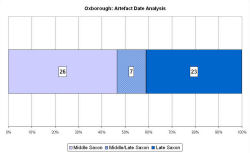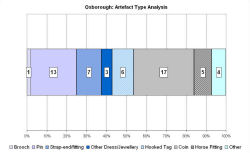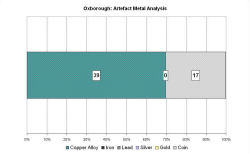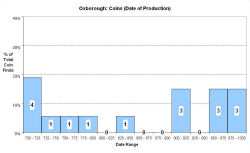Fingerprint charts for i) artefact date analysis, ii) artefact type analysis, iii) artefact metal analysis and iv) coins – date of production




Archives:
http://ads.ahds.ac.uk/catalogue/search/fr.cfm?rcn=NMR_NATINV-356988
http://ads.ahds.ac.uk/catalogue/search/fr.cfm?rcn=NMR_NATINV-380499
http://ads.ahds.ac.uk/catalogue/search/fr.cfm?rcn=NMR_NATINV-1191785
The name 'Oxborough' is derived from the Old English for a fortified place frequented by oxen. Oxborough parish contains the village of that name and the remains of Caldecote village as well as the area to the south-west, which is referred to as Oxborough Hythe. To the south, Oxborough is bordered by the River Wissey; to the north by Caldecote Fen and Fen Wood.
Anglo-Saxon finds have been recovered from the sites of two possible Roman villa complexes. At a site near Caldecote Farm the finds are largely personal ornaments or dress fittings, with some pottery sherds. On the north side of the road that borders the more easterly villa site, large concentrations of Anglo-Saxon metal objects have been recovered, suggesting there was an Anglo-Saxon cemetery close to, or in the grounds of, the Roman villa. The VASLE dataset is derived from the Norfolk HER and the EMC.
Objects from the Early Saxon period are most common, but there have been small numbers of Middle and Late Saxon period objects recovered, including a few horse trappings. By Domesday Oxborough contained two mills and one fishery, although there is no mention of a church. Caldecote, a separate parish at this time, was of considerably less size and value, and again apparently without a church.
Fingerprint charts for i) artefact date analysis, ii) artefact type analysis, iii) artefact metal analysis and iv) coins – date of production




© Internet Archaeology/Author(s)
URL: http://intarch.ac.uk/journal/issue25/2/4.4.43.html
Last updated: Tues Apr 21 2009